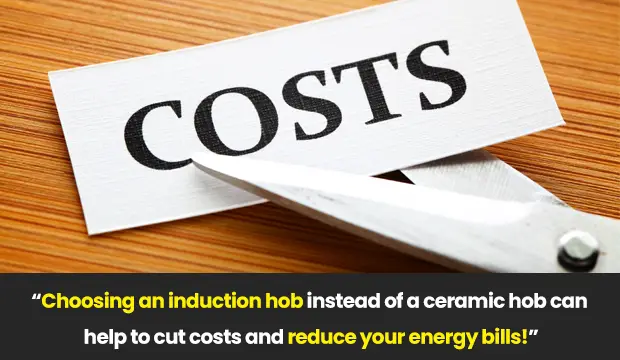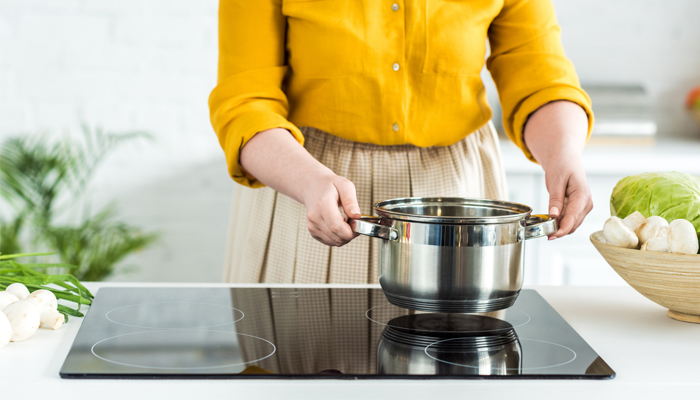It’s well worth checking out induction vs ceramic hob running costs before you choose a new appliance. In the UK, we’re already experiencing higher energy bills with more to come in the near future. There hasn’t been such a huge increase in the cost of home energy for decades.
In 2022 alone, Ofgem anticipates your household energy bills are going to rise by 54% in the spring and a similar amount in the autumn. By this time next year, your household energy could be double what you pay now.
Choosing a hob based on its running costs is suddenly more of a priority than it ever was. Ceramic and induction hobs look identical on the surface. However, they both use significantly different amounts of electricity.
Induction vs Ceramic Hob Running Costs

The purchase price of your appliance isn’t necessarily an indication of how much it might cost to run. At the moment, an average ceramic hob costs between £200 and £300.
An induction hob with similar facilities can cost twice as much. Why pay so much more for an induction hob when it won’t add to the aesthetic appearance of your kitchen?
Many people might hesitate to invest more than they need to in a hob. However, the running costs, both now and in an uncertain future, can make you think twice about which hob to buy.
First of all, we need to look a little deeper into how the two types of hob operate. This should help determine how much they might cost to run over their anticipated lifetime of around fifteen years.
Is an Induction Hob Expensive to Run?
Beneath the ceramic glass, the induction hob has cooking zones made of copper wire. They form part of an electromagnetic circuit that produces its own energy to heat and cook food.
It achieves this by imperceptible, magnetised vibrations which create an alternating current. This energy is then transferred as a form of heat to a pan with a magnetised base and then cooks the food directly.
The electromagnetic field produces and withdraws heat almost instantly. You’ll only need to wait for a second or two for the cooking zone to reach the correct temperature.
When you remove a pan, the magnetised connection is interrupted. The energy source is instantly stopped, leaving the ceramic glass surface comfortably cool to the touch. The induction hob only uses the amount of electricity it needs to activate the hob’s mechanism.
An average induction hob uses an estimated 175 kWh during the year. Before any recent price increase in electricity, this could mean an annual running cost of approximately £34.
Is a Ceramic Hob Expensive to Run?
Underneath the stylish glass cooktop, the ceramic hob has more in common with a regular electric hob than an induction hob.
The burners are usually manufactured from cast iron. They are powered by electricity for the entire length of time you have them switched on.
Cast iron is always slow to heat up. It also retains residual warmth for several minutes after switching off. If you don’t leave a pan in place to continue cooking ingredients with this surplus heat, the glass will feel dangerously hot.
Ceramic hob needs a consistent supply of electricity to keep the burners operating.
An average ceramic hob uses at least 230 kWh throughout the year. At pre-2022 energy prices, this could mean annual running costs of around £50.
Why are Induction Hobs Cheaper to Run than Ceramic Hobs

As you can see, induction vs ceramic hob running costs are significantly different. Their energy-efficiency generally depends on how the burners operate. The induction hob’s burners have a flexible quality. They reach temperatures fast and cut heat with immediate effect.
The cooking zones only produce heat where they connect with a magnetised pan. There’s also no surplus heat being wasted if a pan is smaller than the burner, this equates to an induction hob having an average energy loss of just 10% to 15%.
The ceramic hob is the slowest of all hobs, including gas or traditional electric, in reaching temperature settings.
A ceramic hob’s burners are also fixed in size, this means if you’re using a small pan, the entire burner still needs to be heated, which results in additional heat being lost around the edges. On average, the ceramic hob wastes at least 30% to 35% of its energy.
Conclusion
Induction vs ceramic hob running costs are going to affect your household energy bills in the future. Whether you save or spend more money long-term depends on the hob you choose and the type of hob you are replacing.
The ceramic hob is the most greedy compared to any type of hob when heating up the burners. By comparison, the induction hob starts cooking food as soon as a pan is in place. It doesn’t have any residual heat to waste either.
The cost of your future household energy bills is unpredictable. An energy-efficient induction hob with low running costs could help lessen the impact.
